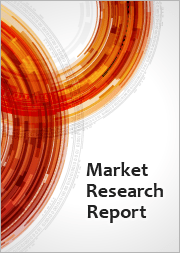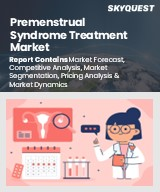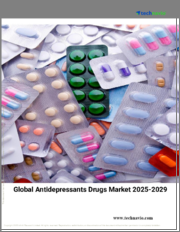
|
시장보고서
상품코드
1698589
세계의 항우울제 시장 기회, 성장 촉진요인, 산업 동향 분석 및 예측(2025-2034년)Antidepressant Drugs Market Opportunity, Growth Drivers, Industry Trend Analysis, and Forecast 2025-2034 |
||||||
세계의 항우울제 시장은 2024년 187억 달러에 달했고, 2025년부터 2034년까지 연평균 복합 성장률(CAGR) 7.5%로 확대될 것으로 예측됩니다.
이 성장은 정신 건강에 대한 관심 증가와 우울증 및 관련 질병에 대한 효과적인 치료에 대한 요구 증가가 주요 요인입니다. 항우울제의 제네릭 의약품을 이용할 수 있게 되어, 특히 저소득 및 중소득 지역에서는 치료비가 저렴해지고, 또 원격 의료나 온라인 약국에 의해 충분한 서비스를 받을 수 없는 지역의 사람들도 정신건강 치료에 접근하기 쉬워졌습니다.
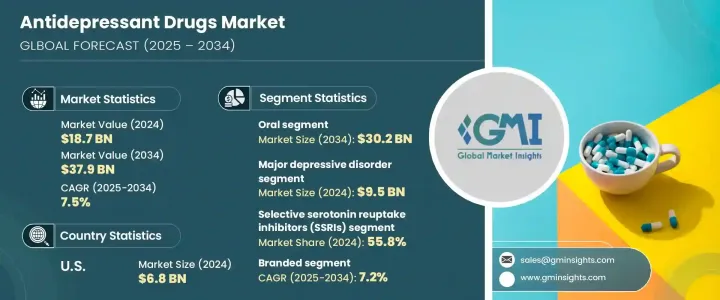
항우울제는 기분, 감정, 행동에 영향을 미치는 신경전달물질을 조정합니다. 세계 시장은 약제 클래스별로 구분되며, 2024년 시장 점유율은 선택적 세로토닌 재 흡수 억제제(SSRI)가 55.8%을 차지했습니다. SSRI는 우울증, 불안장해, 강박성 장애, 패닉 장애, 외상 후 스트레스 장애의 치료에 있어서, 높은 효능, 적은 부작용, 폭넓은 적용성에 의해 널리 사용되고 있습니다.
| 시장 범위 | |
|---|---|
| 시작 연도 | 2024년 |
| 예측 연도 | 2025-2034년 |
| 시작 금액 | 187억 달러 |
| 예측 금액 | 379억 달러 |
| CAGR | 7.5% |
용도별로 시장은 전반적 불안 장애, 우울증 장애, 강박성 장애, 공황 장애, 기타 질병으로 분류됩니다. 우울증에 대한 편견이 희미해짐에 따라 의료 지원을 요구하는 사람이 증가하고 진단률의 상승과 항우울제의 지속적인 수요로 이어지고 있습니다.
시장은 투여경로에 따라 경구제, 주사제, 경비제, 경피제로 나뉘어져 있습니다. 정제 및 캡슐은 쉬운 투여방법, 저렴한 가격 확립된 안전성 프로파일을 통해 여전히 선호되는 선택입니다. 경구 항우울제는 브랜드 제품과 일반 의약품이 모두 있으며 환자의 광범위한 액세스를 보장함으로써 이 부문의 지속적인 이점에 기여합니다.
마약 유형에 관해서는 시장은 브랜드 의약품과 제네릭 의약품으로 나뉘어집니다. 브랜드 의약품 부문은 강력한 마케팅 전략, 브랜드 충성도, 치료 저항성 우울증을 대상으로 한 혁신의 혜택을 받아 예측 기간 중에 CAGR 7.2%로 성장할 것으로 예상됩니다.
유통 채널에는 병원 약국, 소매 약국, 온라인 약국이 포함되어 있습니다. 전문적인 약물을 제공하고 신중한 모니터링과 치료 조정을 통해 더 나은 환자 관리를 보장합니다.
미국의 항우울제 시장은 2024년에는 68억 달러로 평가되었습니다.
목차
제1장 조사 방법과 조사 범위
제2장 주요 요약
제3장 업계 인사이트
- 생태계 분석
- 업계에 미치는 영향요인
- 성장 촉진요인
- 우울증과 불안 장애의 유병률 상승
- 연구개발 투자 증가
- 치료요법과 정신건강에 대한 의식의 고조
- 업계의 잠재적 위험 및 과제
- 일부 항우울제에 따른 부작용
- 약리학적 치료제보다 비약리학적 치료제에 대한 고객의 기호성
- 성장 촉진요인
- 성장 가능성 분석
- 규제 상황
- 파이프라인 분석
- Porter's Five Forces 분석
- PESTEL 분석
제4장 경쟁 구도
- 소개
- 기업 매트릭스 분석
- 주요 시장 기업의 경쟁 분석
- 경쟁 포지셔닝 매트릭스
- 전략 대시보드
제5장 시장 추계 및 예측 : 약제 클래스별, 2021-2034년
- 주요 동향
- 선택적 세로토닌 재흡수 억제제(SSRI)
- 세로토닌 노르 아드레날린 재흡수 억제제(SNRI)
- 삼환계 항우울제(TCAs)
- 비정형 항우울제
- 노르에피네프린 및 도파민 재흡수 억제제(NDRI)
- 모노아민산화효소 억제제(MAOI)
- 기타 약제 클래스별
제6장 시장 추계 및 예측 : 용도별, 2021-2034년
- 주요 동향
- 주요우울 장애
- 범불안 장애
- 강박성 장애
- 공황장애
- 기타 용도
제7장 시장 추계 및 예측 : 투여 경로별, 2021-2034년
- 주요 동향
- 경구
- 주사
- 경비
- 경피
제8장 시장 추계 및 예측 : 약제 유형별, 2021-2034년
- 주요 동향
- 브랜드 의약품
- 제네릭 의약품
제9장 시장 추계 및 예측 : 유통 채널별, 2021-2034년
- 주요 동향
- 병원 약국
- 소매 약국
- 온라인 약국
제10장 시장 추계 및 예측 : 지역별, 2021-2034년
- 주요 동향
- 북미
- 미국
- 캐나다
- 유럽
- 독일
- 영국
- 프랑스
- 이탈리아
- 스페인
- 네덜란드
- 아시아태평양
- 중국
- 일본
- 인도
- 호주
- 한국
- 라틴아메리카
- 브라질
- 멕시코
- 아르헨티나
- 중동 및 아프리카
- 남아프리카
- 사우디아라비아
- 아랍에미리트(UAE)
제11장 기업 프로파일
- Bristol-Myers Squibb
- Eli Lilly and Company
- GlaxoSmithKline
- Intra-Cellular Therapies
- Janssen Pharmaceuticals
- NV Organon
- Novartis
- Opko Health
- Otsuka Pharmaceutical
- Patheon
- Pfizer
- Sandoz
- Sun Pharmaceuticals
- Takeda Pharmaceuticals
- Zhejiang NHU Company
The Global Antidepressant Drugs Market reached USD 18.7 billion in 2024 and is projected to expand at a CAGR of 7.5% between 2025 and 2034. This growth is largely driven by the rising focus on mental health and the increasing need for effective treatments for depression and related disorders. Continuous advancements in pharmaceutical research have introduced innovative drugs targeting treatment-resistant depression, providing faster relief with improved tolerability. The availability of generic antidepressants has enhanced affordability, particularly in low- and middle-income regions, while telemedicine and online pharmacies have made mental health treatments more accessible to individuals in underserved areas.

Antidepressant drugs regulate neurotransmitters that influence mood, emotions, and behavior. The global market is segmented based on drug class, with selective serotonin reuptake inhibitors (SSRIs) holding a dominant 55.8% market share in 2024. Their widespread use is attributed to high efficacy, fewer side effects, and broad applicability in treating depression, anxiety, obsessive-compulsive disorder, panic disorder, and post-traumatic stress disorder. The availability of generic versions has further strengthened their market position by improving accessibility and affordability.
| Market Scope | |
|---|---|
| Start Year | 2024 |
| Forecast Year | 2025-2034 |
| Start Value | $18.7 Billion |
| Forecast Value | $37.9 Billion |
| CAGR | 7.5% |
Based on application, the market is categorized into generalized anxiety disorder, major depressive disorder, obsessive-compulsive disorder, panic disorder, and other conditions. The major depressive disorder segment led the market, reaching USD 9.5 billion in 2024. As awareness grows and the stigma around depression declines, more people seek medical assistance, leading to higher diagnosis rates and sustained demand for antidepressant medications. The necessity for long-term treatment further drives growth in this segment.
The market is divided by route of administration into oral, injectable, nasal, and transdermal formulations. The oral segment accounted for a significant portion of the market in 2024 and is projected to reach USD 30.2 billion by 2034. Tablets and capsules remain the preferred choice due to ease of administration, affordability, and established safety profiles. Both branded and generic oral antidepressants contribute to the segment's continued dominance by ensuring broad accessibility for patients.
Regarding medication type, the market is split into branded and generic drugs. The branded segment is expected to grow at a 7.2% CAGR during the forecast period, benefiting from strong marketing strategies, brand loyalty, and innovations aimed at treatment-resistant depression. Branded medications are often perceived as offering superior efficacy and safety, contributing to their increasing adoption.
Distribution channels include hospital pharmacies, retail pharmacies, and online pharmacies. Hospital pharmacies held a 57.9% market share in 2024 due to the high volume of prescriptions for severe mental health conditions. These pharmacies offer specialized medications, ensuring better patient management through careful monitoring and treatment adjustments. A growing focus on specialized mental health services continues to support market expansion.
The U.S. antidepressant drugs market was valued at USD 6.8 billion in 2024. The high prevalence of mental health disorders, coupled with increasing awareness and a well-developed healthcare system, drives market growth. The accessibility of antidepressants through primary care physicians and mental health specialists ensures a steady rise in demand.
Table of Contents
Chapter 1 Methodology and Scope
- 1.1 Market scope and definition
- 1.2 Research design
- 1.2.1 Research approach
- 1.2.2 Data collection methods
- 1.3 Base estimates and calculations
- 1.3.1 Base year calculation
- 1.3.2 Key trends for market estimation
- 1.4 Forecast model
- 1.5 Primary research and validation
- 1.5.1 Primary sources
- 1.5.2 Data mining sources
Chapter 2 Executive Summary
- 2.1 Industry 3600 synopsis
Chapter 3 Industry Insights
- 3.1 Industry ecosystem analysis
- 3.2 Industry impact forces
- 3.2.1 Growth drivers
- 3.2.1.1 Rising prevalence of depression and anxiety disorders
- 3.2.1.2 Increasing investment in research and development
- 3.2.1.3 Growing awareness regarding treatment therapies and mental health
- 3.2.2 Industry pitfalls and challenges
- 3.2.2.1 Side effects associated with some antidepressant drugs
- 3.2.2.2 Customer preference for non-pharmacological therapeutics over pharmacological therapeutics
- 3.2.1 Growth drivers
- 3.3 Growth potential analysis
- 3.4 Regulatory landscape
- 3.5 Pipeline analysis
- 3.6 Porter's analysis
- 3.7 PESTEL analysis
Chapter 4 Competitive Landscape, 2024
- 4.1 Introduction
- 4.2 Company matrix analysis
- 4.3 Competitive analysis of major market players
- 4.4 Competitive positioning matrix
- 4.5 Strategy dashboard
Chapter 5 Market Estimates and Forecast, By Drug Class, 2021 – 2034 ($ Mn)
- 5.1 Key trends
- 5.2 Selective serotonin reuptake inhibitors (SSRIs)
- 5.3 Serotonin and noradrenaline reuptake inhibitors (SNRIs)
- 5.4 Tricyclic antidepressants (TCAs)
- 5.5 Atypical antidepressants
- 5.6 Norepinephrine-dopamine reuptake inhibitor (NDRI)
- 5.7 Monoamine oxidase inhibitors (MAOIs)
- 5.8 Other drug classes
Chapter 6 Market Estimates and Forecast, By Application, 2021 – 2034 ($ Mn)
- 6.1 Key trends
- 6.2 Major depressive disorder
- 6.3 Generalized anxiety disorder
- 6.4 Obsessive-compulsive disorder
- 6.5 Panic disorder
- 6.6 Other applications
Chapter 7 Market Estimates and Forecast, By Route of Administration, 2021 – 2034 ($ Mn)
- 7.1 Key trends
- 7.2 Oral
- 7.3 Injectable
- 7.4 Nasal
- 7.5 Transdermal
Chapter 8 Market Estimates and Forecast, By Medication Type, 2021 – 2034 ($ Mn)
- 8.1 Key trends
- 8.2 Branded
- 8.3 Generic
Chapter 9 Market Estimates and Forecast, By Distribution Channel, 2021 – 2034 ($ Mn)
- 9.1 Key trends
- 9.2 Hospital pharmacies
- 9.3 Retail pharmacies
- 9.4 Online pharmacies
Chapter 10 Market Estimates and Forecast, By Region, 2021 – 2034 ($ Mn)
- 10.1 Key trends
- 10.2 North America
- 10.2.1 U.S.
- 10.2.2 Canada
- 10.3 Europe
- 10.3.1 Germany
- 10.3.2 UK
- 10.3.3 France
- 10.3.4 Italy
- 10.3.5 Spain
- 10.3.6 Netherlands
- 10.4 Asia Pacific
- 10.4.1 China
- 10.4.2 Japan
- 10.4.3 India
- 10.4.4 Australia
- 10.4.5 South Korea
- 10.5 Latin America
- 10.5.1 Brazil
- 10.5.2 Mexico
- 10.5.3 Argentina
- 10.6 Middle East and Africa
- 10.6.1 South Africa
- 10.6.2 Saudi Arabia
- 10.6.3 UAE
Chapter 11 Company Profiles
- 11.1 Bristol-Myers Squibb
- 11.2 Eli Lilly and Company
- 11.3 GlaxoSmithKline
- 11.4 Intra-Cellular Therapies
- 11.5 Janssen Pharmaceuticals
- 11.6 N.V. Organon
- 11.7 Novartis
- 11.8 Opko Health
- 11.9 Otsuka Pharmaceutical
- 11.10 Patheon
- 11.11 Pfizer
- 11.12 Sandoz
- 11.13 Sun Pharmaceuticals
- 11.14 Takeda Pharmaceuticals
- 11.15 Zhejiang NHU Company







